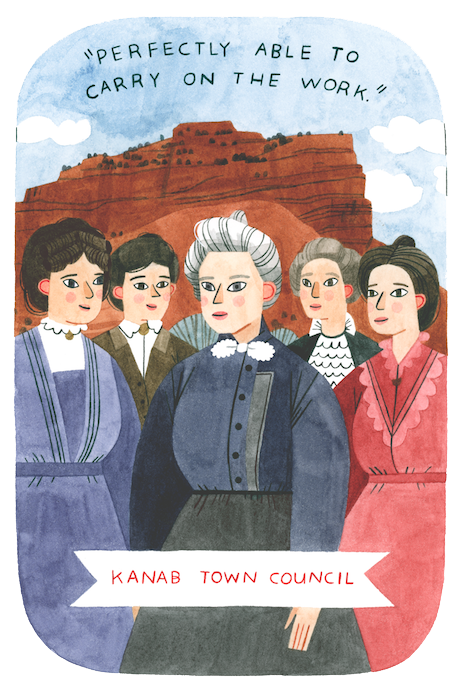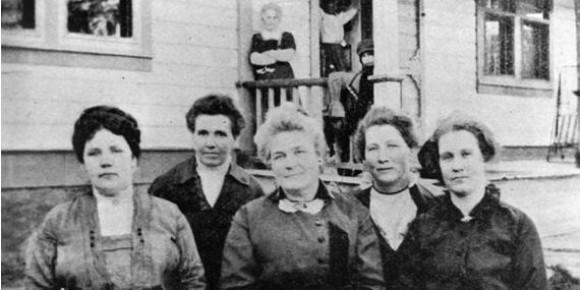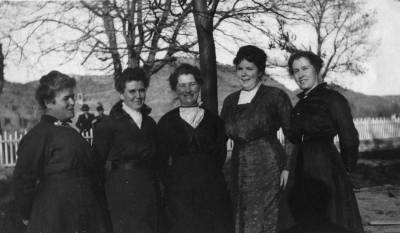
Kanab Town Council,
The Petticoat Government
1912-1914
“Perfectly able to carry on the work”
By Kylie Nielson Turley
On 7 November 1911, Tamar Hamblin, Luella McAllister, Blanche Hamblin, Vinnie Jepson, and Mary Chamberlain were elected as members of the Kanab Town Council with Mary Chamberlain elected as council chair (mayor). The women’s election “surprised and perturbed”[1] the women since they “had no campaign & were elected before [they] knew any thing [sic] about it.”[2] Others put them on the ballot as a joke, though who got the last laugh is debatable, since the women reversed the prank: they accepted their election and served as “trustees” (councilmembers) for the 1912-1913 term. Despite opposition, the women passed and enforced laws and influenced citizens to tidy up the cow town, which earned them a place in history as the first all-woman town council in Utah.[3]
At their first meeting in January 1912, Vinnie Jepson resigned for undisclosed reasons. Ada Pratt Seegmiller was appointed to fill her place.[4] At 41 years of age, Mary Chamberlain was the oldest of the group, followed by Blanche (38), Vinnie (32), Tamar (31), Ada (30), and Luella (26). Each of the five women was married and raising young children, 36 in total. Three of those children were born during their mothers’ term in office. Two of the women worked outside of the home: Mary Chamberlain as a clerk in Kanab’s mercantile store and Tamar Hamblin as a “practical” nurse.[5] Blanche Hamblin was a “thrifty, ambitious and scrupulously clean” housewife[6], as was industrious Ada Pratt Seegmiller, who sewed clothing for her thirteen children and maintained a home in Kanab and another in Salt Lake City after her husband was elected to the state legislature. Available records do not indicate Luella McCallister’s occupation, though she was certainly busy raising her stepson and her own six children.[7]

The Kanab Town Council, 1912-1914, from left to right: Luella McAllister, treasurer; Blanche Hamblin, councillor; Mary W. Chamberlain, president; Tamar Hamblin, clerk; Ada Seegmiller, council. Courtesy of Utah State Historical Society.
Why did these busy mothers run for town council? In her 1936 Life Sketch Chamberlain insists the “election was intended as a joke.” Apparently no one signed up to run for office, so “loafers on the ditchbank (of which there were always plenty) proceeded to make up the above ticket as a burlesque.”[8] While many have assumed that the women thought they would do a better job than men or that the men wanted women to run things because they were tired of their complaints, it is more likely that the “joke” was due to a generational clash between the “restless” younger men and the older men who had dominated the town for years. The simmering dispute erupted during 1911 over the local newspaper, perhaps motivating the young loafers to put the woman on the ballot as a way to mock the older generation. That may have been why Chamberlain was “disgusted” when she heard she was elected.
The women typically held their meetings at their homes, sometimes met on Sundays, and regularly began with prayer. Votes were usually unanimous, though Chamberlain noted that they had to “set aside [their] personal feelings” in order to work “for the public good.”[9] During their term, the women passed eight ordinances. They platted the Kanab cemetery,[10] regulated “Peddlers and Traveling Merchants”[11] and placed restrictions on stray pets and livestock,[12] a law which evidently did not solve the problem; ordinances regulating stock yards and imposing a dog leash law[13] were passed within months. Why they outlawed slingshot in the city limits is unknown, but they imposed a fine of $.25 for the first offense and $.50 for subsequent ones.[14]
The woman town council also regulated “Sabbath-breaking and Gambling,” making it a crime for citizens to “indulge in ballgames, foot races, horse races of in any noisy outdoor amusement within the limits of this town” on Sunday, as well as criminalizing “any game of cards, dice, horseshoe, pitching” or “any other game of chance.”[15] The women also felt alcohol was a “terror to our town” and attacked “the liquor evil” [16] in a five-page ordinance.[17]

From left to right: Mary W. Chamberlain, Blanche Hamblin, Tamar Hamblin, Luella McAllister, and Ada Seegmiller. Courtesy of JoLynn Hoyt.
One writer exaggerated that “not a soul has ever found it in his heart to criticize those remarkable women,”[18] but Tamar Hamblin’s poem claimed the opposite: that “all” the women received “was fault-finding, / Never an encouraging word.”[19] Mary Howard admitted that the women “have more than [their] share” of “opposition” and revealed that “Some members meet it every day in their own homes.” They also faced animosity outside their homes. “Indignant” about a $1.50 fine for stray cows, the men of Kanab refused to comply, and the women were forced to hire a “great, big, brave, courageous” city marshal to enforce the law. But the marshal was “twitted about being under a petticoat government.” Finding a man who did not resign after becoming “the town joke” was impossible: the women hired seven different marshals during their short term and were forced to “skimp and save from every other avenue of expenditure” so they could offer an “enormous salary” to entice someone to take the job.[20] Likely hostility would have been even greater had the women sought office as a feminist statement.
Despite the opposition to their ordinances, Chamberlain hoped the town would “elect other ladies to fill the vacancies” in government because the women were “perfectly able to carry on the work” or even “better able” than men who had to “[look] after their sheep, cattle, etc.,” thus leaving the town “without any supervision.”[21] Ada Seegmiller was successfully re-elected (although she resigned at the first meeting in January 1914), but Kanab’s council was not flooded by women trustees. Perhaps women were deterred by opposition or perhaps they felt, like Sarah Blanche Hamblin, that they were “mothers of families—not ladies of leisure who needed politics for a hobby.”[22] Nevertheless, the prank election, though unsolicited, opened the door for an ordinary group of southern Utah women to step into elected office, manage a small frontier town, and take their place in history.
Kylie Nielson Turley’s 2005 Utah Historical Quarterly article on Kanab’s all-woman town council won the Morris Rosenblatt/Charles Redd Center for Western Studies Award for Best General Interest Article. A generous grant from the Charles Redd Center for Western Studies at Brigham Young University has supported this research.
Footnotes
[1] Gates, “Utah Women,” 14.
[2] Mary Howard, “Kanab, May 20, Anna H. King” letter in Edwin Woolley Jr. and Erastus Snow Family Collection, BYU Special Collections, 1.
[3] The first all-woman town council in the United States may be the council elected in 1888 in Oskaloosa, Kansas, made up of Carrie Johnson, Sadie Balsley, Emma Hamilton, Hannah Morse, Mary Loman (mayor) and Mittie Golden. See Kansas Historical Society, “The First All Woman City Government, Oskaloosa, Kansas,” Kansas Memory, Kansas Historical Society, 2007-2018. Accessed 21 July 2018.
[4] Kanab (Utah) City Council Minutes, March 1884 to January 1920. Series 84960, Reel 1., Utah State Archives and Records, Salt Lake City, Utah, 13 November 1911, 245, 254.
[5] Elsie Chamberlain Carroll, History of Kane County, published by Kane County Daughters of Utah Pioneers, subsidized by the Coordinating Mayors’ Council of Kane County. SLC: Utah Printing Company, 1960, 76.
[6] Louise Hamblin Haycock, “Personal History of Louise Hamblin Haycock,” Walter Eugene and Blanche Robinson Hambiln and Their Descendents, Helen Cram Starr, compiler, (Yorba Linda, CA: Shumway Family History Services, 1992), copy in possession of Donna Gae Hamblin Burgoyne, Kanab, Utah, 28.
[7] See 1920 United States Census, Luella M. Mcallister, Utah, Kane County, Kanab, 7th and 8th January, 3A, www.acestry.com, accessed 12 April 2005.
[8] Farel Chamberlain Kimball, comp. Mary E. Woolley Chamberlain: Handmaiden of the Lord, An Autobiography (SLC [?]): Published by the family, 1981, Division of Archive and Manuscripts, L. Tom Perry Special Collection, Harold B. Lee Library, Brigham Young University, Provo, Utah.
[9] Howard, “Example,” 867.
[10] “Town Ordinance,” Kanab County Revised Ordinances, 96? (28 March 1913).
[11] See “An Ordinance regulating Peddlers and Traveling Merchants, and Repealing Subdivisions 2 and 3 of Section 6 of the Revised Ordinances of the Incorporated Town of Kanab,” Kanab County Revised Ordinances of the Incorporated Town of Kanab. Series 84920, reel 1., Dept. of Finance, Utah State Archives and Records: SLC, 85-86? (23 February 1912).
[12] “Impounding Animals,” Kanab County Revised Ordinances, 87-89? (8 May 1912).
[13] “Stock Yards,” Kanab County Revised Ordinances, 91? (1 July 1912); “Dogs,” Kanab County Revised Ordinances, 93? (29 July 1912).
[14] Flipper Ordinance, Kanab County Revised Ordinances, 90 (28 May 1912).
[15] “Sabbath-Breaking and Gambling,” Kanab County Revised Ordinances 100? (14 April 1913).
[16] Howard, “Example,” 867.
[17] “An ordinance to prohibit the manufacture, sale, keeping for sale or distribution of intoxicating liquors, passed by the President and board of Trustees of the Incorporated Town of Kanab,” Kanab County Revised Ordinances of the Incorporated Town of Kanab. Series 84920, reel 1., Dept. of Finance, Utah State Archives and Records: SLC, 102.
[18] Robinson, “Town Business,” 12.
[19] Tamar Hamblin, “Aunt Blanche,” Walter Eugene and Blanche Robinson Hambiln and Their Descendents, Helen Cram Starr, compiler, (Yorba Linda, CA: Shumway Family History Services, 1992), copy in possession of Donna Gae Hamblin Burgoyne, Kanab, Utah, 15.
[20] Howard, “Example,” 865.
[21] Howard, “Example,” 865.
[22] Haycock, “Life of Sarah Blanche,” 13.

